Discover practical, experience-based tips for helping your child succeed in swim lessons. Learn what to do, what not to do, and how to ensure swimming is a safe and positive experience.
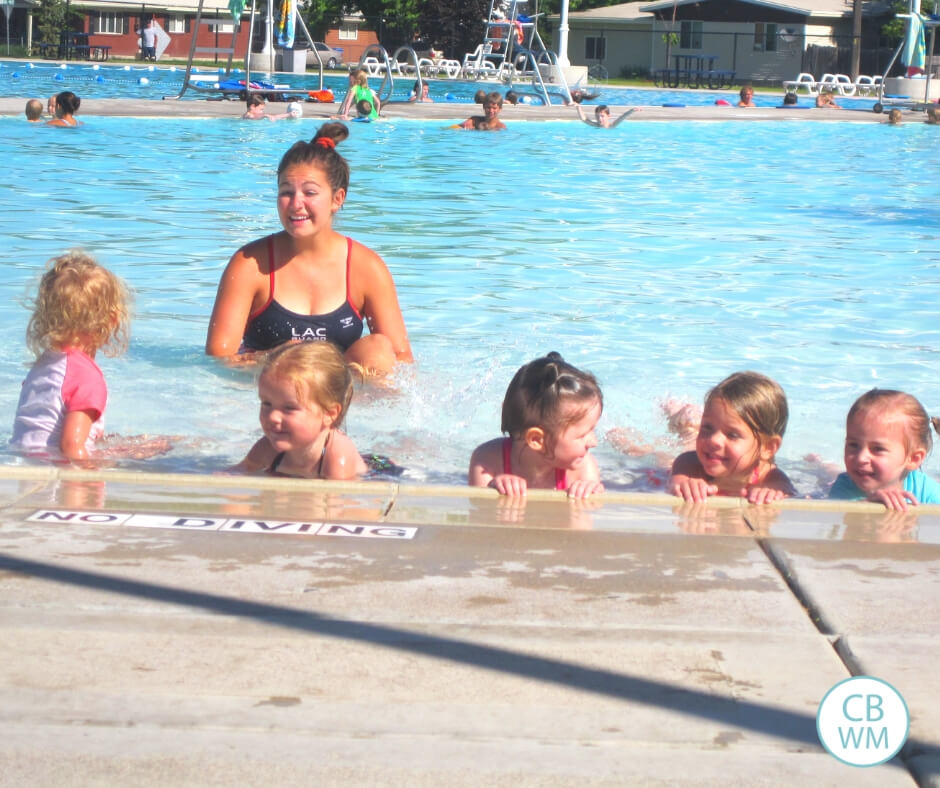
I never learned how to swim. As a result, there are many water activities I do not feel particularly comfortable participating in. I often felt insecure in the water, and rightly so.
Because of this, I really wanted my children to be capable swimmers. I put my children in lessons at a young age. I quickly moved to hiring a private swim teacher so my children could get one-on-one training. I really only ever hoped to have my children be safe and comfortable in the water. We went much beyond that, however!
When I first wrote this post, I had three children who had completed the full swim lessons. One of those three was a competitive swimmer and was about to join the high school swim team as a freshman. My youngest child was still taking swim lessons. Since then, she has also completed her swimming lessons.
Swimming lessons are not optional for me. According to various organizations like the CDC and the WHO, drowning is the third leading cause of death in unintentional injury death. In the United States, drowning is the leading cause of death of 1-4 year olds and the second leading cause of death of 5-15 year olds. Just because your child can touch the bottom of a pool in the shallow end won’t mean your child is in the clear. 80% of those deaths happened in a residential pool with an adult present.
So swimming lessons are valuable and important on many levels. There is a safety component and simply a fun component–it is more fun to participate in water activities if you feel comfortable in the water.
As parents, we want our child to succeed in life. We also want to help in any way we can with different processes in our children’s lives. We don’t, however, always intuitively know the best things to do to actually be helpful. I think this is especially true for swimming lessons.
Here are tips of what to do as parents and what not to do to help your child succeed at swimming lessons.
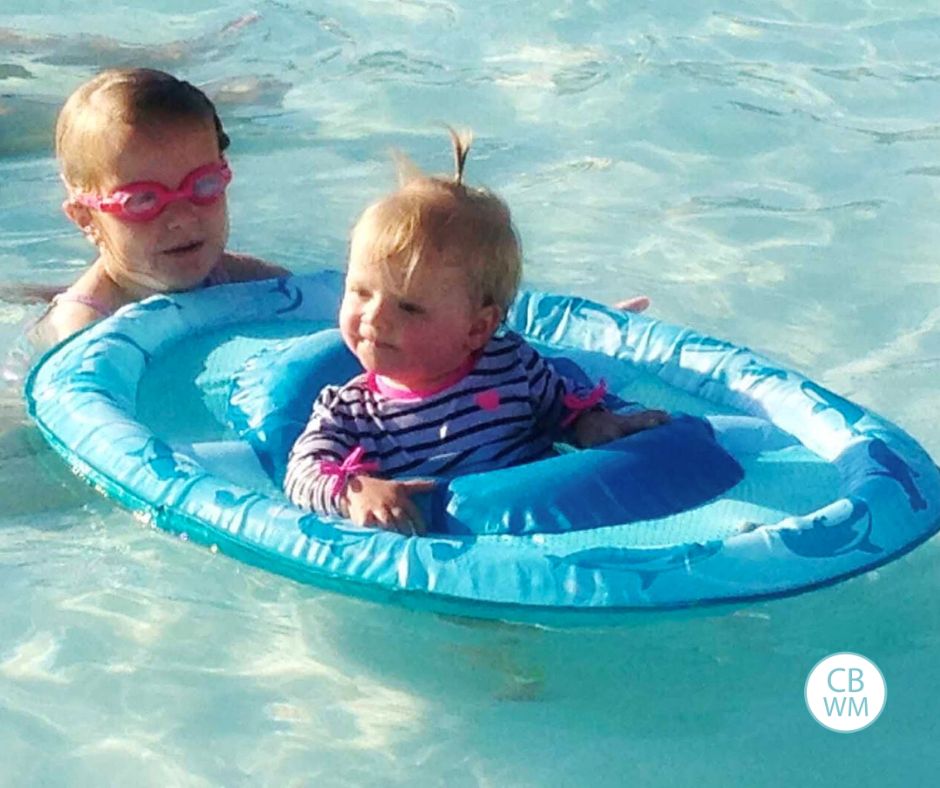
Post Contents
- Get Your Child Used to the Water
- Start Swimming Lessons Young
- Find a Good Pool and a Good Teacher
- Ask and Tell
- Be Patient Through the Process
- Have Appropriate Expectations
- Swim at Other Times
- Crying is Okay
- Talk to the Teacher
- There Will Be Hard Times
- Set Goals
- Have Good Equipment
- Swimming Equipment
- Conclusion
- More Swimming Posts
Get Your Child Used to the Water
Before your child takes swimming lessons, it is very helpful if you can get your child comfortable in a swimming pool. Do not assume that comfort in a tub will equate to comfort in a pool. The two locations are very different– the temperature of the water, the size of the container, and the ability to touch the bottom and sides are just a few examples of extreme differences in the two. So take your child to the pool at times.
Once you know the pool you will have lessons at, it would be an excellent idea to take the child there before the first lesson. Your child will likely do better than he would otherwise at his first lesson if the pool is familiar to him.
If your child is not used to the water, do not be surprised or frustrated if your child spends a lot of time crying at swimming lessons initially.
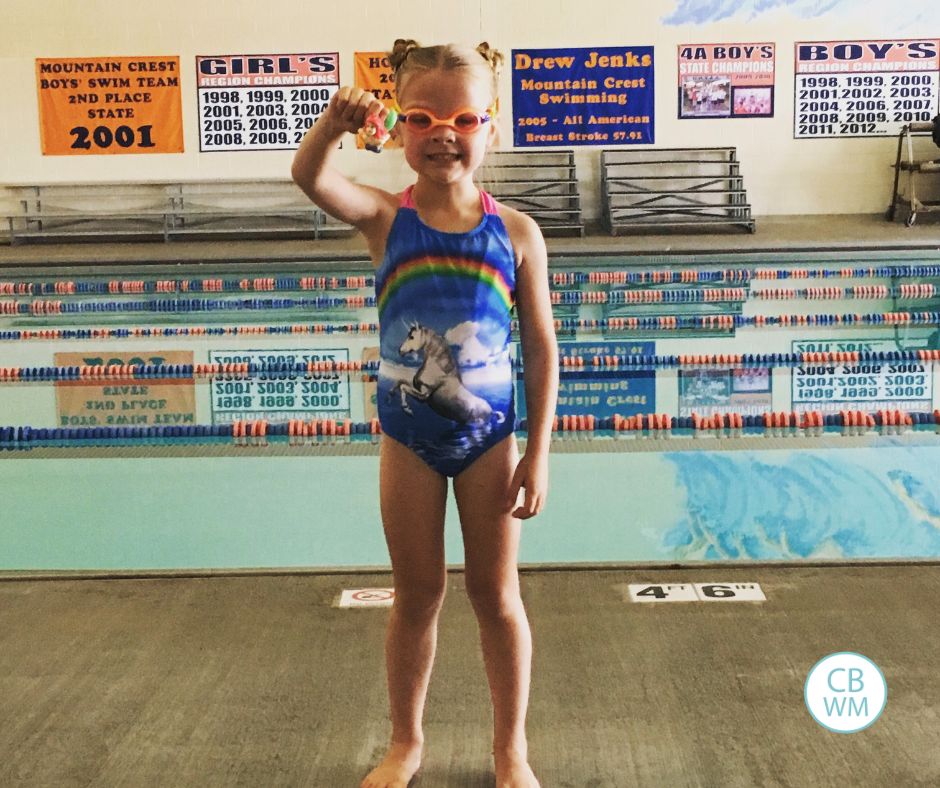
Start Swimming Lessons Young
We had the same swim teacher, Hailie, for at least 8 years doing private swim lessons. She also coached for the swim team and was over the public swim lessons. I asked for her input for this post. Her first piece of advice was to start young.
She said, “No matter the child, don’t wait past the age of 4.” She said she has found that waiting longer just leads to an increased fear of the water and that makes it harder for the teacher to break that fear. She also said it is a lot easier to work with a scared 3 year old than a scared 5 or 7 year old.
The AAP is now recommending parents start swim lessons for their children starting around age 1.
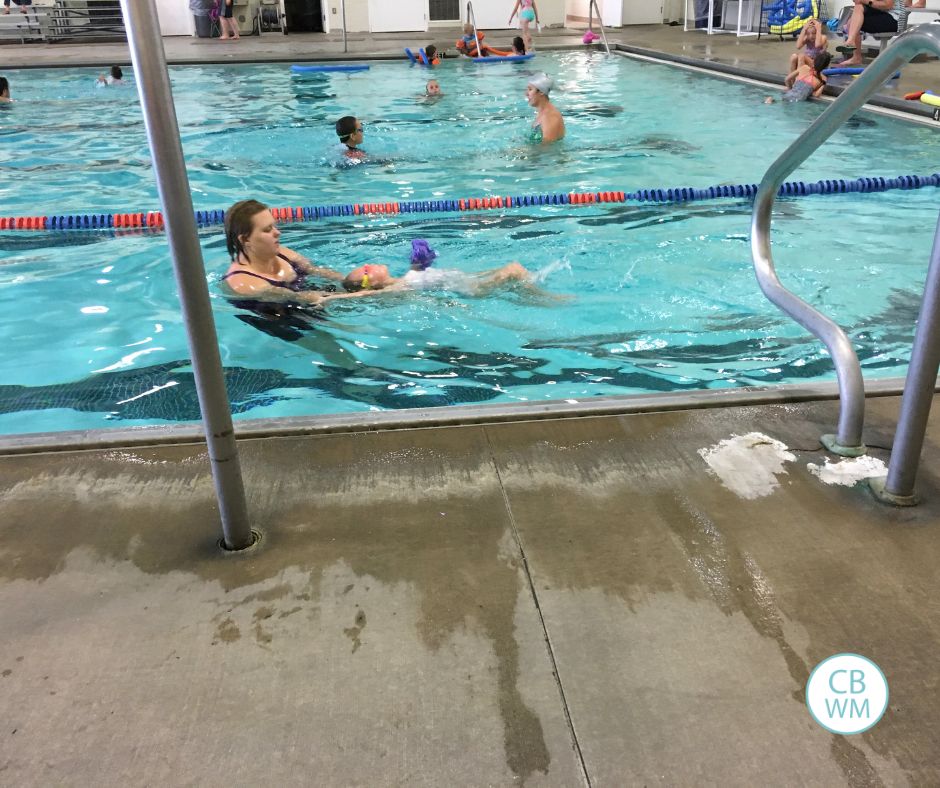
Find a Good Pool and a Good Teacher
Ask around to find a good program. You will want input from people who have very recently been in lessons–programs can drastically change quickly. We started at a pool where I was not impressed with the quality of teaching. They also seemed to pass everyone to the next level whether they should move on or not and grouped children based on age, not on ability.
I get that kids have fun with peers, but it isn’t doing the children favors so far as really learning to swim. My point for swimming lessons was for my children to be able to safely swim in the water.
We ended up moving pools and finding a private teacher. I have loved that!
Hailie said that no matter where your swim lessons are, if the public swim classes have more than 6 kids to a class, it is not worth it. That will not give your child enough instruction time. She also pointed out that a lot of public swim teachers are inexperienced, so you want to be sure there is a supervisor walking around and helping teachers. “If you can’t identify a clear supervisor, the lesson program is no good” Hailie told me.
Do not be afraid to ask what sort of life-saving skills the swim teacher will add to the lessons. Our teacher taught the children what to do if they fell in the water, got too tired in the water while swimming, or felt worried or panicked for any reason.
I will note that our private teacher eventually moved on and wasn’t available to teach anymore. This was when Brinley was still learning to swim. She had times she went to group lessons before we found a private teacher we liked again. Those group lessons proved to be helpful in two ways. One is that kids will often face fears when they are in a group of peers because they don’t want to “look like a baby.” Another is they might feel like, “If that kid can do it, I can, too.” So group lessons can be a form of positive peer pressure.
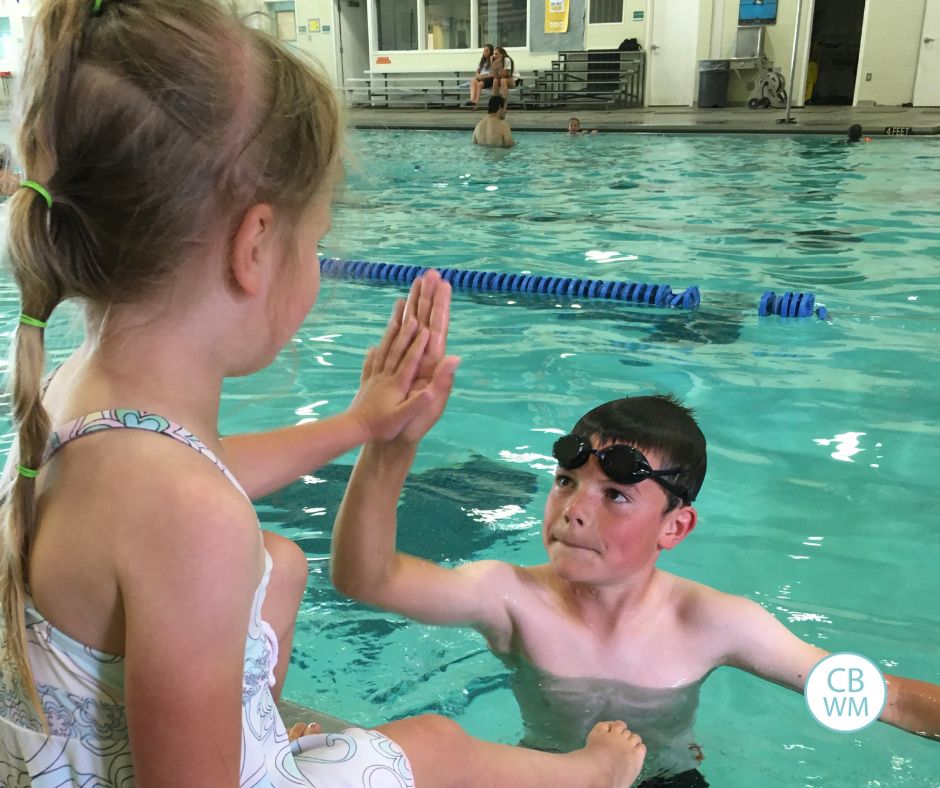
Ask and Tell
I think there are things we parents really prepare our children for. Take the dentist. We know that the dentist can be scary. We talk to our children about the dentist and practice at home.
Another example is potty training. We get potty books, watch potty videos, and talk about it with our child before diving into the training process.
With swimming, however, we often just take the child to the pool and expect the child to embrace learning to swim.
Learning to swim is at least as scary as the dentist. It is literally quite easy to die in a pool–not so much in a dentist’s chair. Swimming is also a lot more challenging than learning to change from peeing and pooping in a diaper to doing it in a toilet. I am not taking anything away from the difficulty of potty training–it is often a difficult process. But it is a natural process. Learning to swim is usually not natural for a child.
So spend some time mentally preparing your child for swimming lessons. If you don’t know, find out what the child will learn to do at first during swim lessons. Explain it to your child. Talk about what will happen and what it will be like.
Be honest. Tell your child it might be hard and maybe even seem scary, but that you know your child can succeed if she tries. Talk about how it will be so exciting to learn to swim. Be honest and say it will be hard work.
Tell her that the teacher will be very nice and that she can trust this stranger who is going to ask her to put her face in the water. Talk about how fun it will be to get in the pool more often.
Tell your child what you expect of your child. “You are not allowed to tell the teacher no. You need to obey the teacher just like you need to obey Mommy.” Also, talk consequences for failure to follow through with consequences. This is a process known as Ask and Tell and is quite an effective parenting tool for all sorts of situations.
Finally, be sure your child knows that all you want is for your child to try her best. You don’t care how fast she learns or picks up on it all, just that she is trying.
Children have very different rates of progress through swimming. Some are more natural than others. Some often have trouble staying buoyant when young due to lower body fat content. Some can’t progress quickly until their body proportions reach a certain place. Be satisfied with the best effort from your child.
Now, you know your child best. If you feel like there are things you shouldn’t discuss unless necessary, go with your gut. For example, some children might not even think that swimming could be considered scary until you said, “It might be scary.” With children like that, you wouldn’t want to tell your child she might be scared. Consider what you think your child needs to hear before the first lesson to be successful and go with that.
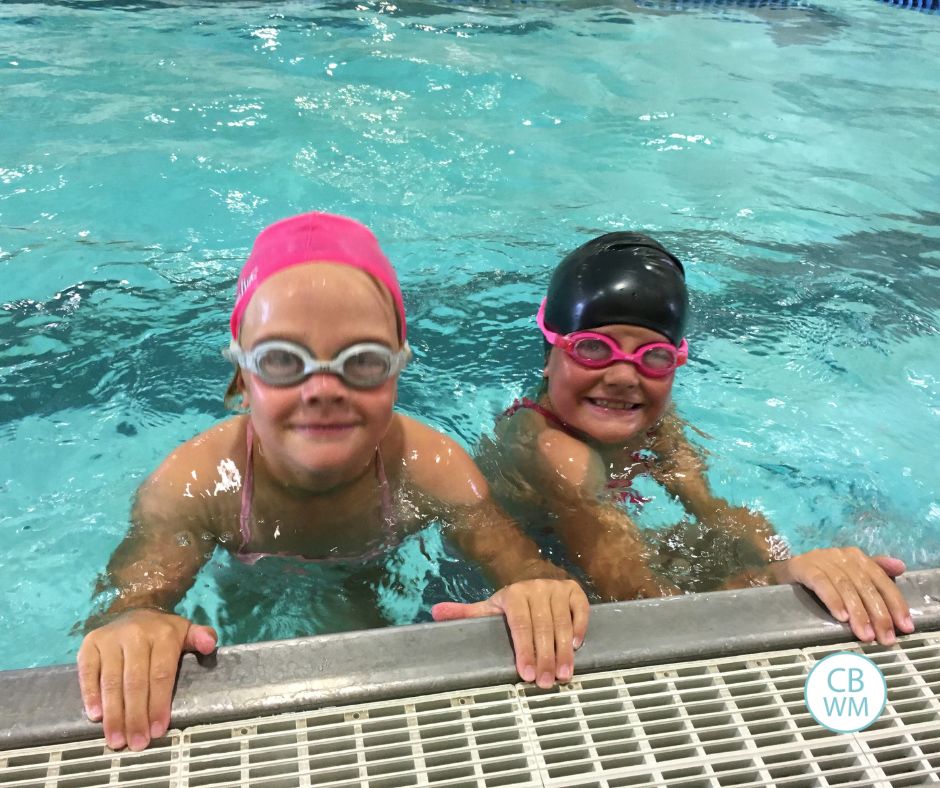
Be Patient Through the Process
All children are very different in the process of learning to swim. Brayden started out scared. He was very scared, but always did what was asked. As time went on, he slowly got less scared. New skills would make him nervous–like flip turns and dives–but he progressed in a linear way. Today he is on the swim team.
Kaitlyn started out with no fear. Then she grew to be scared (thanks to an inexperienced teacher who left Kaitlyn out alone…not great). She then was fine again. Then got scared again and declared she would never put her face in the water. Then she was fantastic. Then she got really scared for no known reason. Then she was fine and didn’t look back. She didn’t have as much trepidation about dives or flip turns. Hesitation, but not fear. She has passed everything off now and can swim very well.
McKenna started off fearless. She progressed rather quickly–probably too quickly. I think her skills grew faster than her maturity level to handle the skills. She also got ear tubes and the water really bothered her ears. In retrospect, we should have tried ear plugs. She went through a time of crying through her lessons after progressing several levels in with no issues. We had to sit out of her site or she would refuse to do what her teacher asked. We tried pulling her from lessons for a short time. She didn’t really improve greatly until the ear tubes were out. Once the ear tubes were out she went back to progressing quickly and loving swimming. She has since passed off all skills and is a strong swimmer.
Brinley has also passed off all skills other than dives. She started life with no fear of the water. She spent a lot of time in the pool just because we were in the pool a lot. She had moments of fear and moments of being fine like Kaitlyn did. We found she did much better if mom or dad were not there. If we were there, she would cry for us and want us. So we spent a couple of months dropping her off and walking out of the pool area or up to the observation area where she couldn’t see us. After a couple of months of that, she got much better and I could sit poolside with no issues. She never did dives because she is scared of heights and just couldn’t get her body to cooperate. As hard as she tried, she only ever jumped in, never dove. Since she wasn’t aiming for the swim team, we decided that was fine.
My point in sharing these stories with you is to encourage you to be patient as your child works through the process. There will be ups and downs. If you all stick with it, though, you will come out successful in the end.
It is important to know that children gain skills, then plateau for a bit, then gain skills, then plateau.
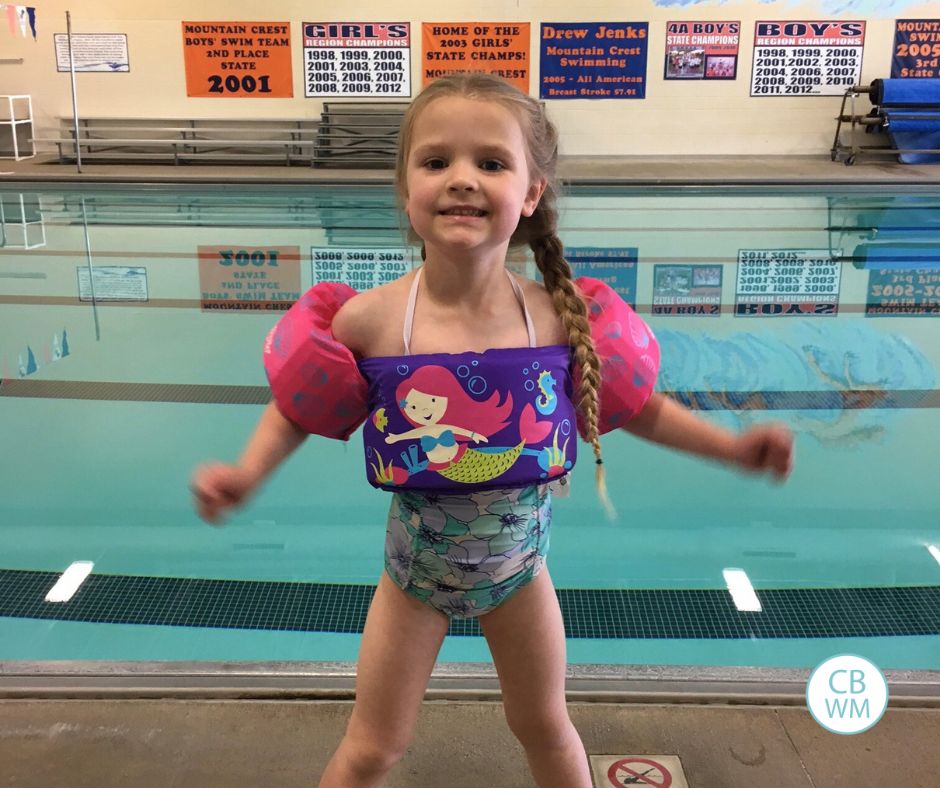
Have Appropriate Expectations
It is wise to know what you can really expect out of swim lessons. Hailie, our swim teacher, pointed out that if you only do swim lessons during the summer, you need to realize that the child will have forgotten skills during the time since last summer (just like kids forget school skills during summer). She recommended starting out your summer lessons on the last level the child passed off as a refresher and then taking the next level up.
You will also need to do more than one class in the summer if you want to see real progress. Whether you do private or public, you can’t just do a handful of lessons and expect there to be a vast improvement. For public lessons, Hailie recommended 2-3 sessions (at eight 30 minute lessons each). For private lessons, she recommends eight to ten lessons of 30 minutes each of one-on-one time.
We tend to do private lessons once a week during the summer. We then do every week during the school year at times and every other week during the school year at times. I like the slow and steady approach. That is just how I roll. We enjoyed having swim lessons consistently and year-round.
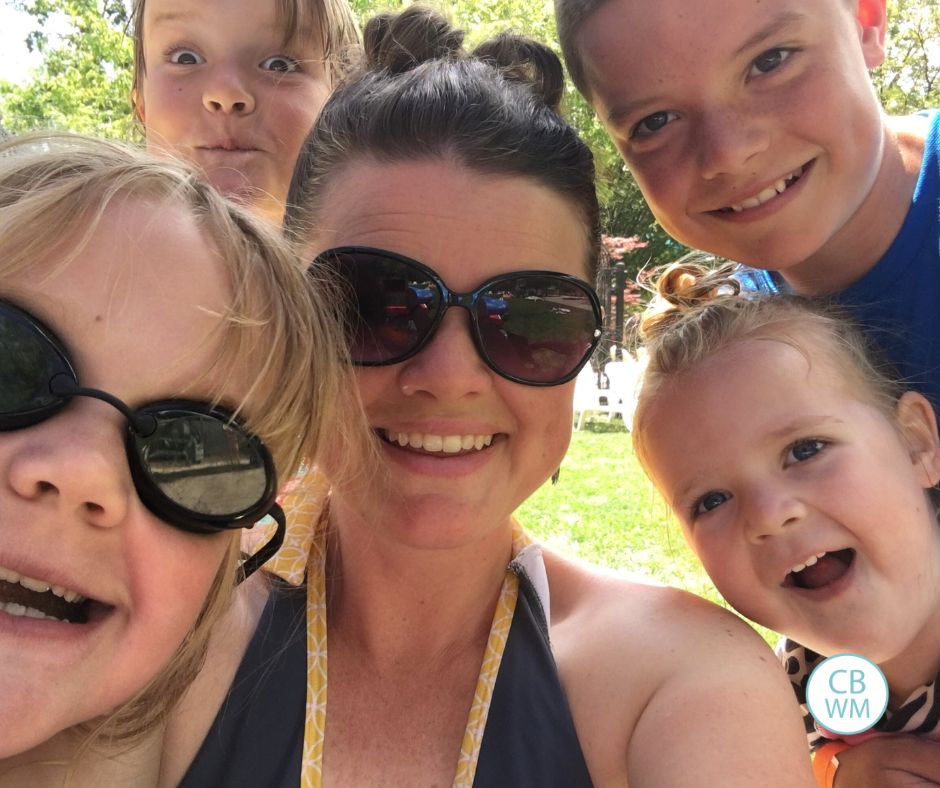
Swim at Other Times
During the time period of lessons, keep that familiarity up with the pool. When our children were younger and feeling nervous about lessons, we made a point of going swimming just for fun. We would just have fun and eventually encourage the child to show us what he/she had learned in lessons so far. We would count to see how long the child could float on the back. We would help the child practice skills he/she was afraid of doing with the teacher.
Learning to swim is a skill just like learning to play the piano. It is helpful to get practice outside of a lesson. It doesn’t make sense to expect a mastery of swimming with swimming happening only at lessons just like it doesn’t make sense to expect the ability to play the piano if piano playing is only happening during lessons. This is especially true in a group lesson setting where kids usually wait on a platform or on the side of the pool when the teacher is not working with them. Their time spent swimming is short.
Another comparison could be made with softball or baseball. You probably wouldn’t expect your child to improve only at games. You would expect some practice would need to happen outside of games to really make improvement. Kaitlyn had soccer practice 2-3 times per week as well as 2-4 games a week. Even with all of that, she needed to do some practicing of skills at home to improve in certain areas.
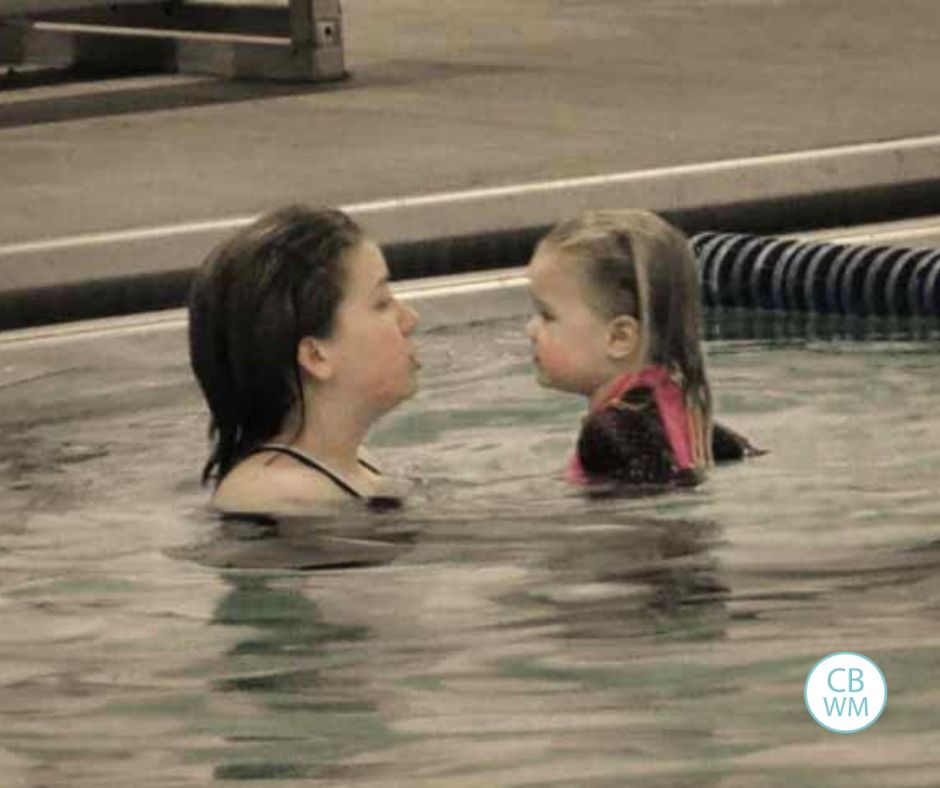
Crying is Okay
It kind of seems like most children go through a phase of crying or at least being upset during lessons. It is usually best to stay out of it if your child is crying. Do not go to the side of the pool and try to talk your child into being okay with the lesson. Most of the time it is best to leave the child with the teacher and let it be worked out.
It would be wise to talk with the teacher beforehand and find out their policy and expectations. I think many times parents approach the child because they don’t want to leave some poor teacher with their screaming child.
If the teacher tells you beforehand, “I’ve done it a million times. It is best for you to just let the child be if she cries” then you will feel more confident in letting the teacher handle it. Let the teacher know that you will stay back unless she signals for you to step in.
You might need to sit where the child can’t see you. When McKenna had a hard time, her teacher told me that almost always the child would stop crying if she couldn’t see the parent.
Hailie, our swim teacher, said to stay out of the way of the teacher. She said, “Even if you have the screaming 3 year old, leave them. They kind of go into ‘survival mode’ after a short time and start to do what the teacher wants only because the teacher is the only person around they have a connection to. If mom is still there, they will scream for hours and hours.”
Talk to the Teacher
This leads me to just talk to the teacher. Find out what the teacher wants from you and doesn’t want from you. Parents often interfere in the process too much, but again, I think that is the parents trying to be good parents. It is helpful for you to know proper expectations just like it is helpful for your child. These teachers teach a lot of kids and know what generally works and what doesn’t.
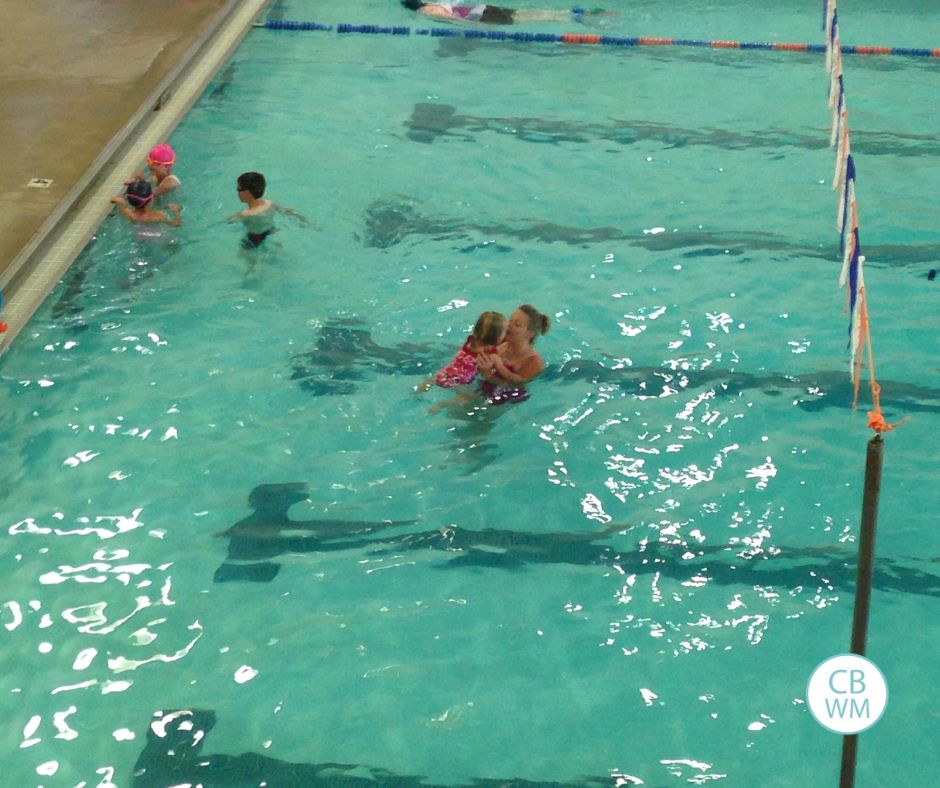
There Will Be Hard Times
Hailie pointed out that many parents do not understand what it takes to learn to swim. She said that to teach a child to swim, the child will have to feel what it is like to sink a little. The child is going to go underwater and will likely get water up the nose. The child will probably cray about that (see crying section above). She emphasized to “let the teacher keep teaching.” Many times when a child cries, it means they are being pushed to learn. And that is why you are paying money for lessons right? To learn. You could spend less money to just go hang out in the pool.
Set Goals
We made a sticker chart for each child for passing off various strokes and skills. Any time a child passed something off, we all went out for ice cream on our way home from that lesson.
That was a very motivational tradition. When the kids felt like giving up, they kept ice cream in mind and pushed through. Brinley, now 12, recently brought up this tradition and mentioned how fun it was.
We did swimming lesson refreshers in the summer once the child had passed off all skills. So the child had time with our teacher and she ran them through workouts. She corrected any poor form habits that may have crept up in the time off. Then she issued challenges (get a 50 freestyle in under a minute) and once they meet that challenge, we went out for ice cream. She kept the challenges hard enough that we didn’t go out every lesson.
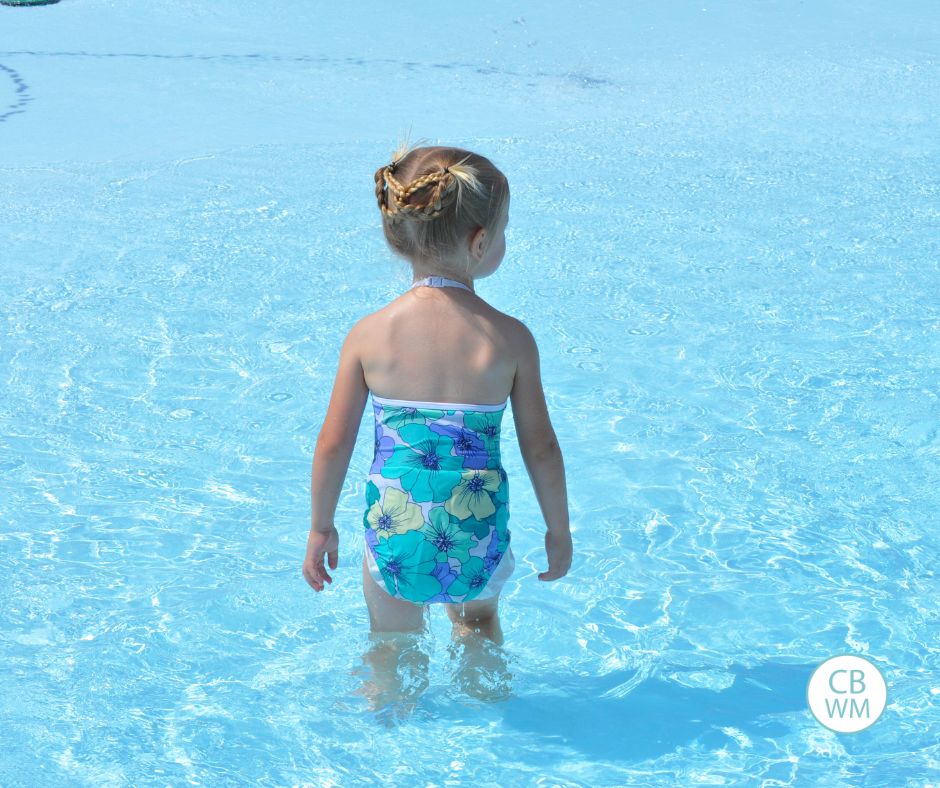
Have Good Equipment
You shouldn’t need much for swimming lessons. One thing to consider is the use of goggles and flotation devices.
Initially, I didn’t want my kids using goggles because I didn’t want them dependent on goggles. However, I learned they did better with goggles.
Looking back, I don’t see an issue with goggles. Swimmers on swim teams use goggles. And through the years, my kids can all go into a pool without goggles and still have an enjoyable time. Also, if you are going to get goggles, get good ones. I have to buy goggles from a swim shop–not even the “box store” googles of the same brand are very good. We like Speedo brand goggles.
There is a lot of debate surrounding flotation devices. Some people swear by them. It is a way to get children comfortable with the water. Others swear they only harm. They say they discourage proper technique and can also give a false sense of safety. Know the opinion of the pool you will be taking lessons from and find a pool that lines up with your own opinion. If you get a floatation device, go with a life vest type of jacket!
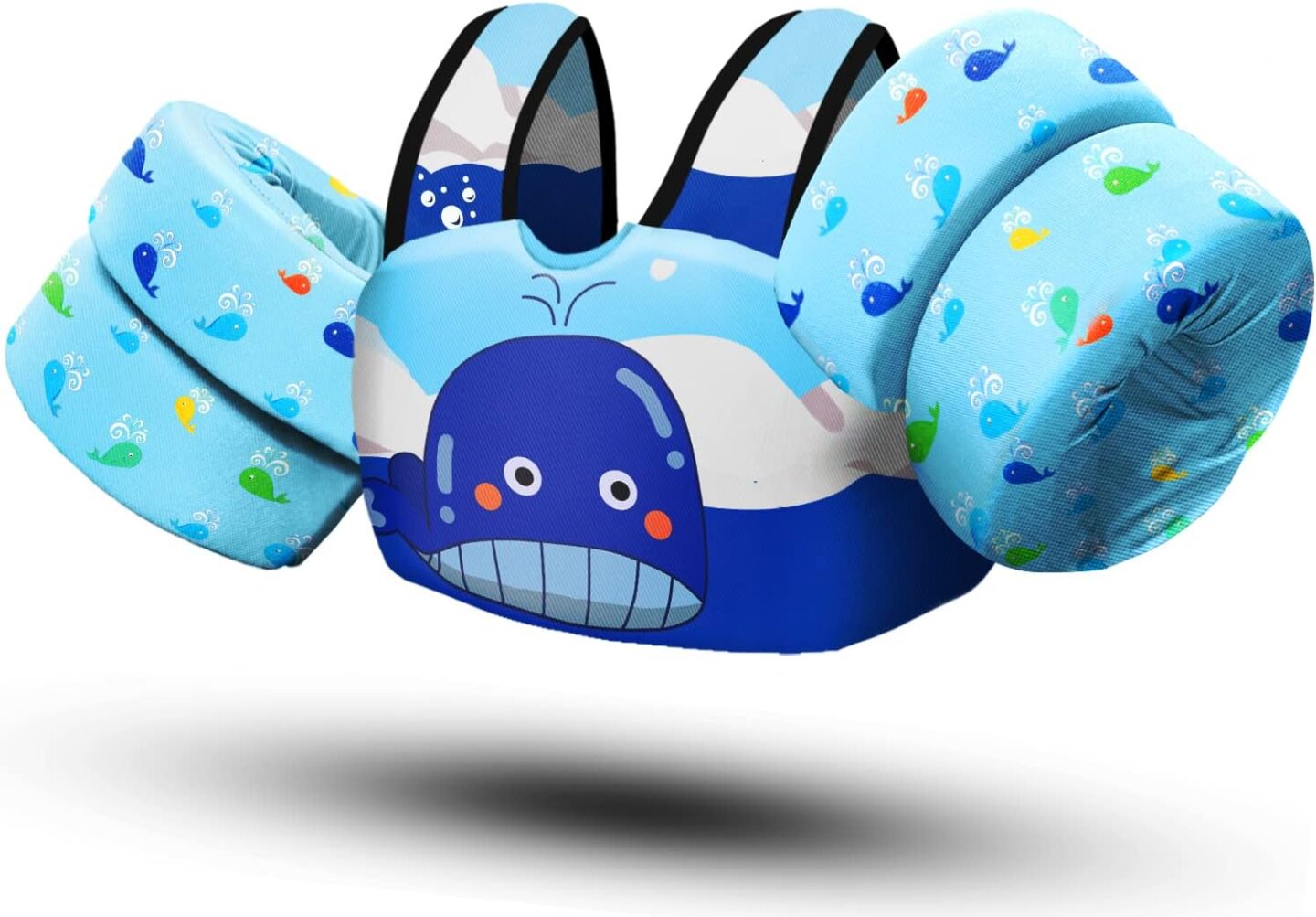
I love having a mesh bag to store swim equipment in. Then the items can breathe and dry out. I prefer using microfiber towels for swim lessons. They are small and dry off quickly. If you plan to spend a lot of time in a pool, get a high-quality swimming suit that can withstand the chlorine. Uglies and Speedo are good brands. Speedo also has nice suits for avoiding wedgies.
Toys can be very helpful for keeping your child happy and engaged in the water. Do not add toys to swim lessons unless you talk to the teacher first. There is other equipment that kids use as they progress (like a kickboard and flippers). If the pool does not have that equipment, your teacher will let you know what to get.
If your lessons are outside, do not forget the sunblock!
Swimming Equipment
Conclusion
Expect swimming to take time. Your child won’t master it in a short swimming lesson session. Be patient with the time your child needs. With time, your child will get it. Choose a good program, know their policies and expectations, trust in their process, and stay out of their way.
More Swimming Posts
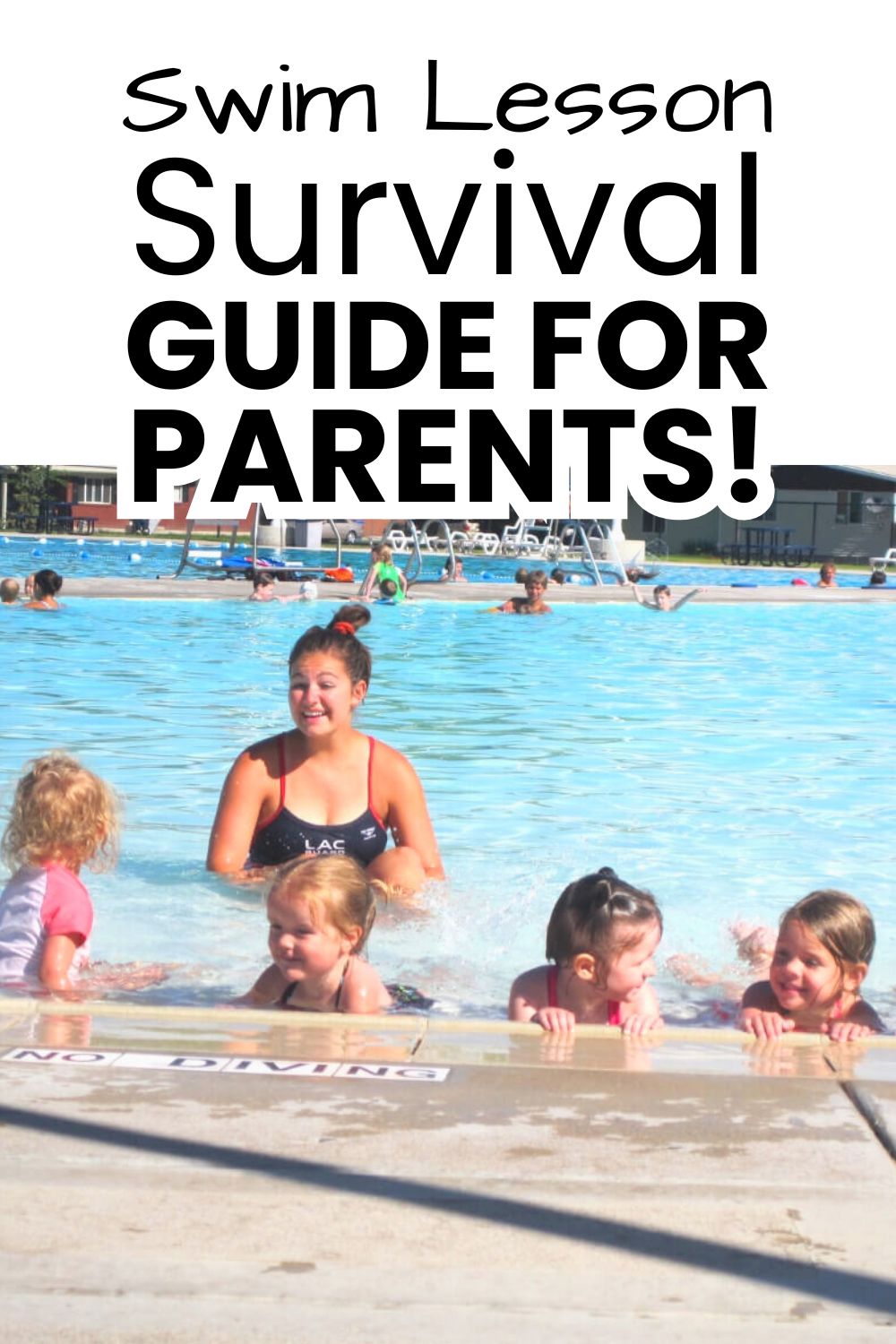
This post first appeared on this blog in May of 2019



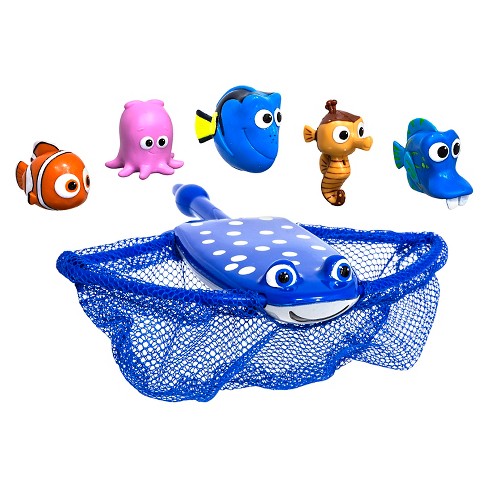









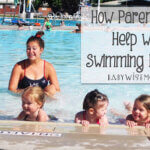

Thank you. This is very helpful and so timely as I have just been thinking how I need to look into swimming lessons for my daughter.